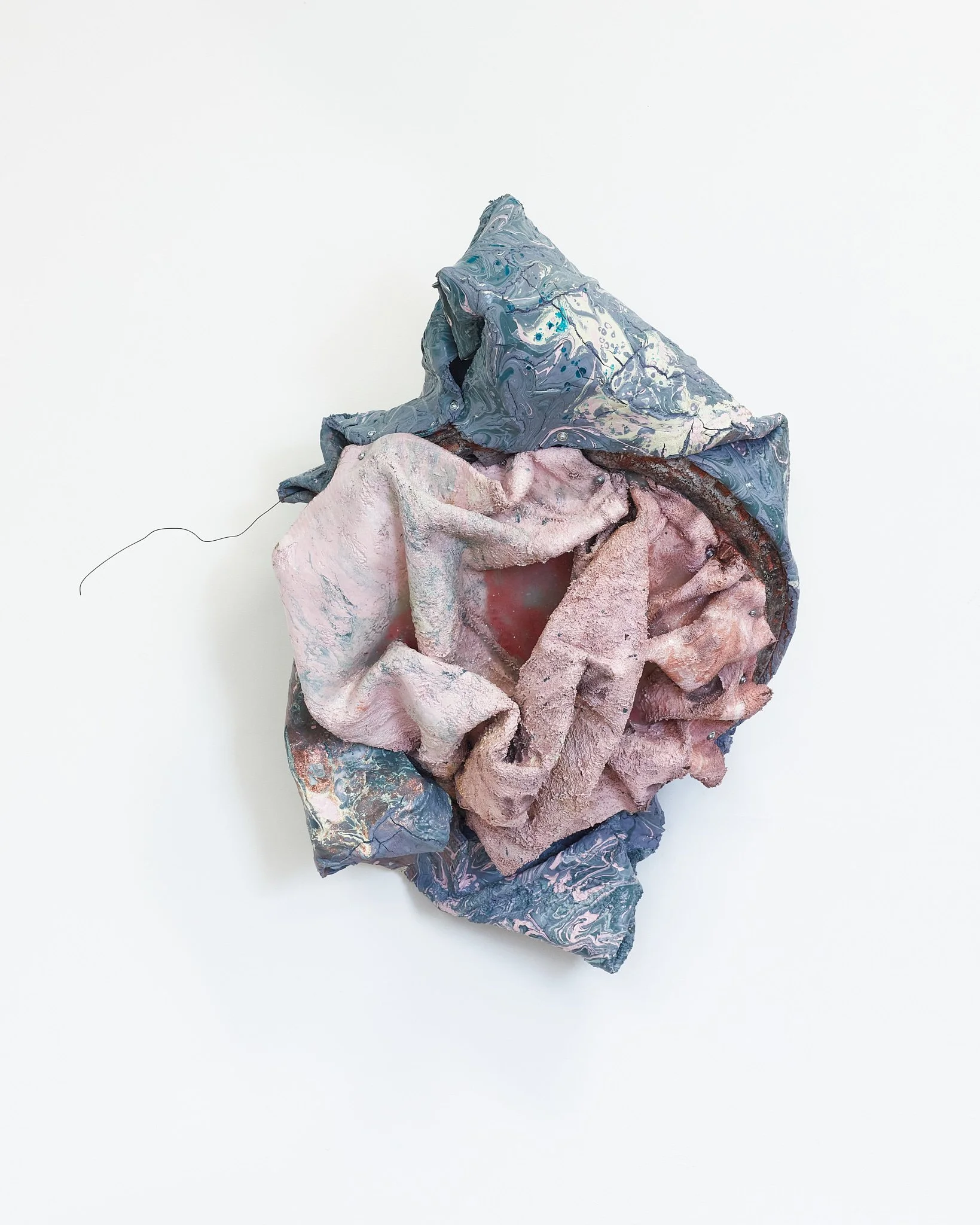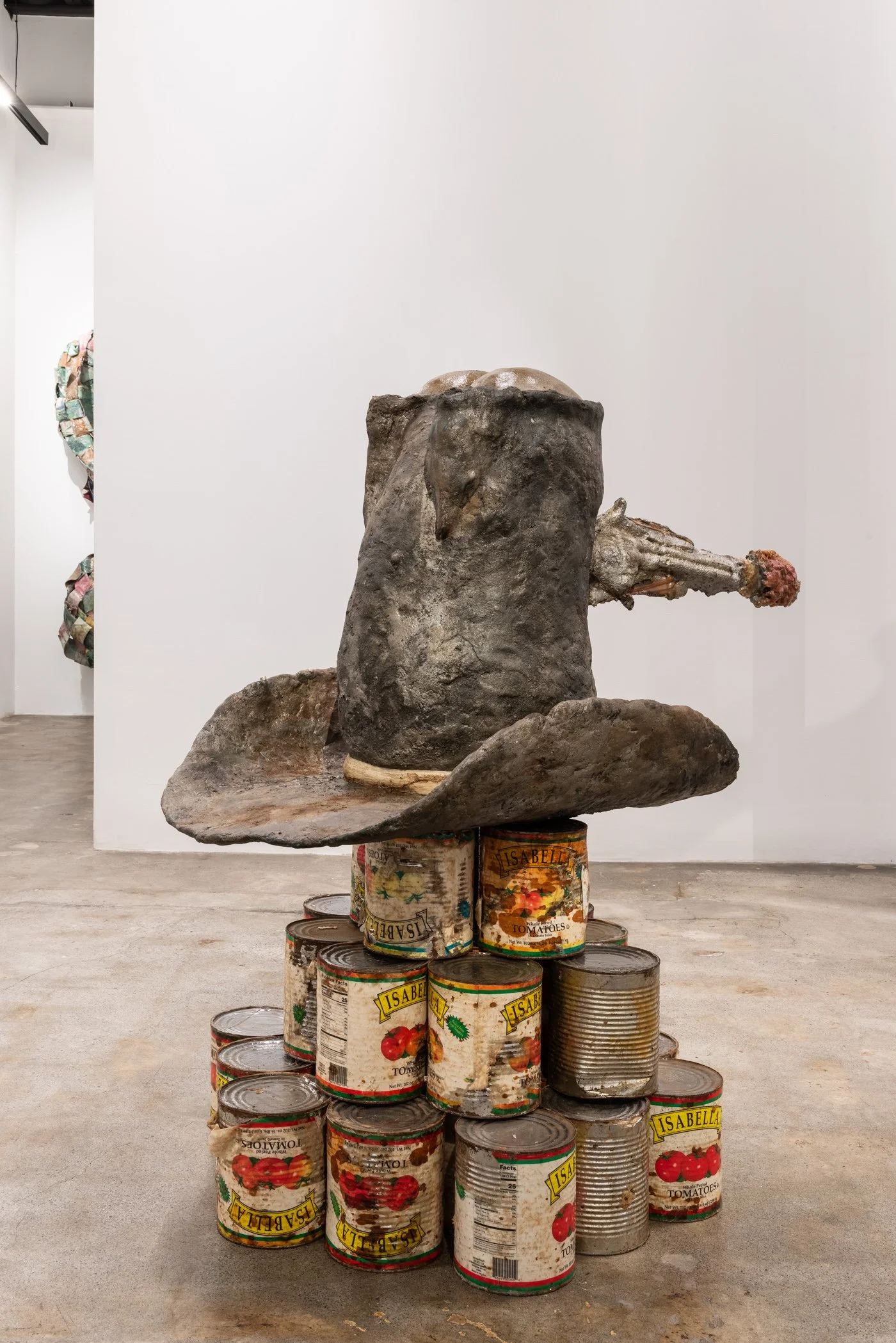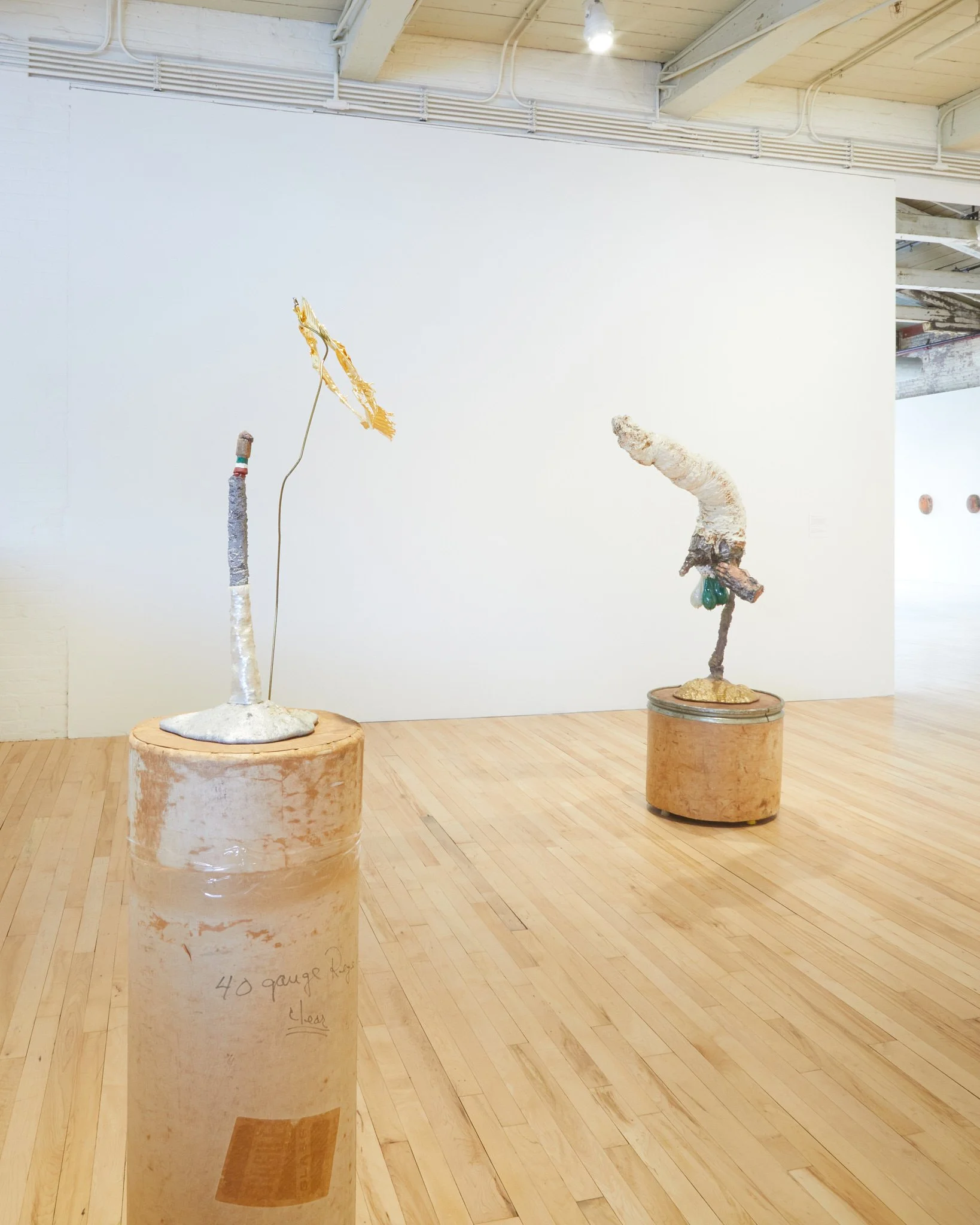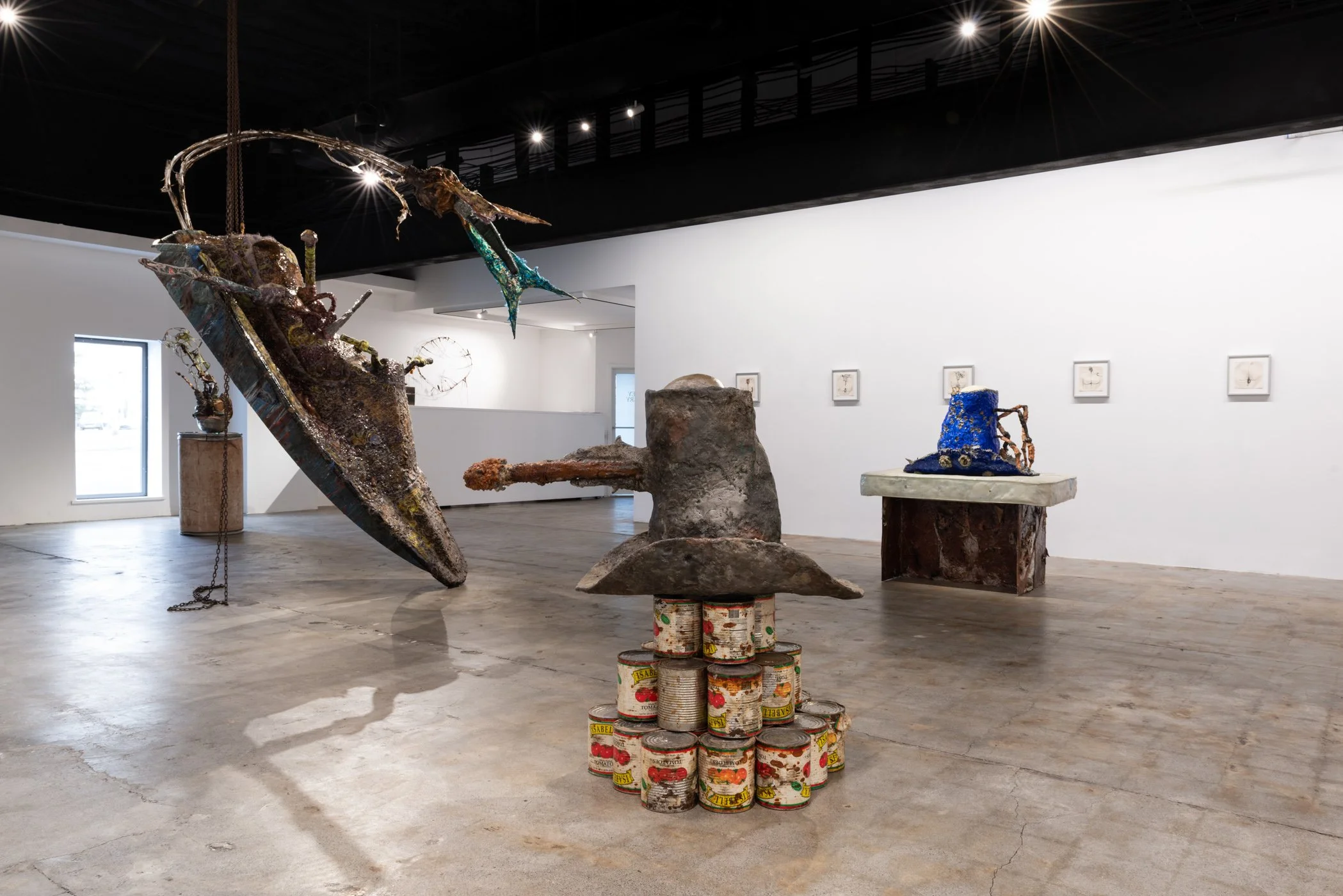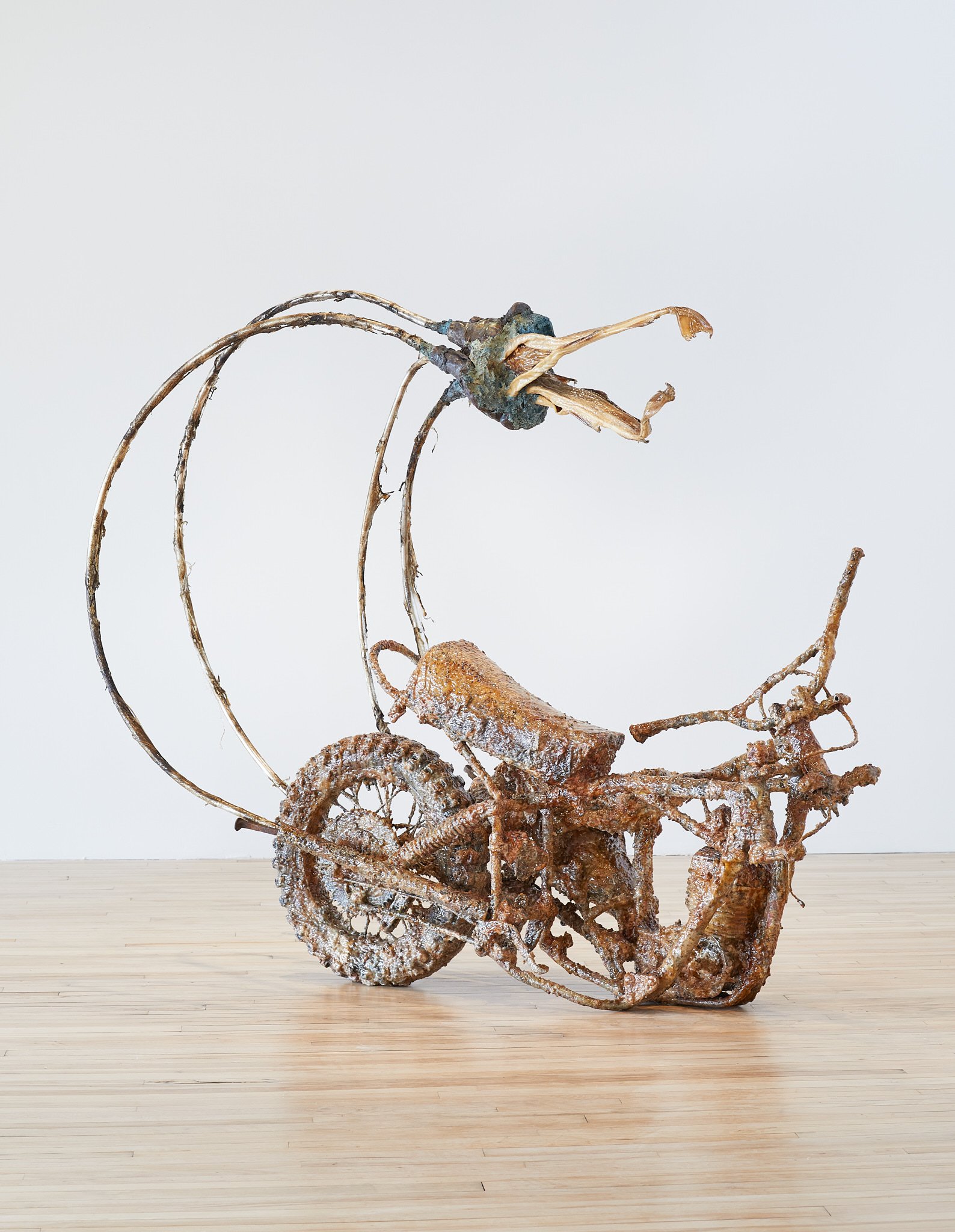The Decadent World of Daniel Giordano
Installation view of Love From Vicki Island at MASS MoCA. Photograph by Ernesto Eisner.
Mounting a solo exhibition is a major undertaking for an artist, a whirlwind of negotiation, curation, and logistics. Putting on two solo exhibitions at once is, of course, twice as challenging. But three? Artist Daniel Giordano, based upstate in Newburgh, has three overlapping solo exhibitions: JDJ Gallery in TriBeCa, Turley Gallery in Hudson, and MASS MoCA in North Adams, Massachusetts. Each show offers a different perspective on Giordano’s diverse and materially complex oeuvre, featuring bodies of work that draw from the artist’s life and surroundings while allowing each piece to take on a life and meaning of its own.
Fact VII: A Rose is a Rose is a Rose (Giordano), 2022, Acrylic polymer emulsion, bath towels, glitter, hardware, my hair, oil-based paint, pigment, plywood, pomade, rubber, tire, water caltrop, 33 x 30 1/2 x 13 3/4 in. Photograph by Ernesto Eisner.
Giordano organizes his artistic output into multiple series of related works. Examples from the Pleasure Pipes series and studies of his brother occupy spaces in all three venues. The exhibition at JDJ, in addition to the pipes and studies, also has small works from his Cannoli series – based on the Italian dessert. The Fact series consists of wall-mounted works that blur the boundary between painting and sculpture. Made from acrylic polymer emulsion, bath towels, and many other materials, including the artist’s hair, Fact VII: A Rose is a Rose is a Rose (Giordano) (2022) is a form folded back upon itself — invaginated — so that the boundary between inside and outside is unclear. It exists in an uneasy stasis: not definitively a sculpture or a painting, not interior or exterior; simply itself.
Talent I (Titanic), 2016-2020. Aluminum, artificial teeth, brick, cable ties, canned tomatoes, cattails, clay, deep-fried batter, dental floss, Dior lipstick, epoxy, fibered aluminum coating, hardware, hardware cloth, hematite, hosiery, iron quartzite, Nesquik strawberry powder, phosphorescent acrylic, rubber, shellac, silicone, wax, wood, 48 x 36 x 32 in. Image courtesy of Turley Gallery.
The Turley Gallery exhibition features a wide range of Giordano’s work, including a series of small drawings surrounding several monumental pieces. Each work in the Talent series takes the form of a large cowboy hat with a cast of the artist’s buttocks forming the characteristic crease at the top. Talent I (Titanic) (c. 2016) has the hat seated on a pyramid of tomato cans. It also contains artificial teeth, Dior lipstick, Nesquik strawberry powder, and more conventional materials. The most physically imposing piece in the show at Turley is My Scorpio II (c. 2015), which consists of a heavily modified 1989 Yamaha jet ski. The vessel has been marbled with nail polish, burned with a torch, and embellished with tennis ball fuzz and Tang drink mix.
My Scorpio I, 2016–2019. 1970s Husqvarna motocross bikes, aluminum, Canadian maple syrup, cattails, ceramic, deep-fried batter, epoxy, phosphorescent acrylic paint, plastic wrap, railroad spikes, steel, stockfish, urinal cake, 88 x 72 x 24 in. Photograph by Ernesto Eisner.
Another piece from Giordano’s Scorpio series is on view at his exhibition at MASS MoCA. My Scorpio I (2016-2019) is one of the artist’s most iconic works, a pair of 1970s Husqvarna motocross bikes deep-fried like calamari. The act of deep-frying dirt bikes sounds absurd but makes perfect sense according to the internal logic of Girodano’s work. The museum show also features an entire room of pleasure pipes and a room devoted to the artist’s mask-like self-portraits. In addition, the exhibition features many studies of the artist’s brother mounted atop industrial barrels. Study for Brother as La Pulcinella (2016-2020) is a sizeable phallic shape with Truck Nutz painted in the colors of the Italian flag dangling beneath like an old man’s testicles.
Installation view of Love From Vicki Island at MASS MoCA. Photograph by Ernesto Eisner.
Jasper Johns’s adage, “Take an object. Do something to it. Do something else to it,” is amplified and extended towards infinity in Giordano’s practice. Every element of every work is transformed and manipulated in some way — nothing is in a “natural” state. All is artifice. Giordano has several techniques that transform base materials into something more significant and visually captivating. One of these is fire. Many of his works are scarred with scorch marks, and surfaces are bubbled, cracked, and blackened from the heat. Marbling a surface with nail polish is another mode of transformation, activating the surface with swirls and skeins of unnaturally vibrant color. He may also coat it in batter and deep-fry it. Resin or epoxy thickened with cattail fiber is another common material that encases various Italian desserts to keep them from immediately rotting away. But, eventually, they will rot.
The eventual material decay enshrined in Giordano’s work could reflect the artist’s surroundings — the post-industrial city of Newburgh. The city is a strange mix of landmarked houses with sophisticated-sounding names and burned-out husks of long abandoned structures, all on the side of a hill overlooking the Hudson. Giordano’s work rises from the ruins of his hometown and, in its constant state of material degeneration, speeds back toward a fallen state. His works are temporary arrangements of meaningful matter brought together by the artist’s intentions and process. Everything, someday, will return to nothing. The question then becomes: what significance has it had for us in the meantime?
My Scorpio II, 2015-2022, 1989 Yamaha jet ski, aluminum, Canadian maple syrup, cattails, ceramic, construction adhesive, cow teeth, deepfried batter, epoxy, fire glass, glitter, goat skin, hosiery, lichen, manual chain hoist, nail polish, Northeastern Fastdry tennis court surface, oil-based paint, organic matter, phosphorescent acrylic, plastic wrap, PVC glue, PVC primer, rawhide, reactive metallic copper enamel, rocks, silicone, sleeve press board, steel, steel wool, Tang drink mix, tennis balls, thread, Tiger Balm, water-based acrylic paint, window sash weight, wool. 175 x 60 x 104 in. Image courtesy of Turley Gallery.
To Walter Benjamin, the baroque was an aesthetic of ruins. To him, the writers and artists of the baroque didn’t build anything novel ex nihilo but, instead, heaped together fragments of cast-off classical dross, accumulating them until something clicked into place. Likewise, Giordano’s artworks are arrangements of fragments taken from his life and surroundings, all heavily modified and transformed by the artist’s hand. Like the baroque prose described by Benjamin, the fragments are gathered together “in the unremitting expectation of a miracle,” some force that might unify the bits and pieces into a cohesive whole. For Giordano, this force isn’t supernatural: it’s the artistic process itself, the transformation of an object from one state to another.
Aside from being an aesthetic of ruins, the baroque was also an aesthetic of decadence in all senses of the word. Giordano’s work embodies the baroque’s various properties: spectacular, theatrical, maximalist. The historical baroque was contradictory, variously exhibiting predilections towards illusionism and materiality in different contexts. Baroque materiality is inherently dishonest: there is a fakeness to it, a sense that the object at hand isn’t, and cannot be, what it appears to be. The materiality in Giordano’s work isn’t necessarily dishonest but isn’t upfront and straightforward. Food that looks ready to rot might be sealed away in epoxy or resin and could last another thousand years unchanged. Or it could crumble away tomorrow. As with baroque trompe l’oeil, appearances cannot be trusted.
Installation view of The Misadventures of Buddy Crapo: by Land, by Sea, and by Air at Turley Gallery. Image courtesy of the gallery.
Giordano uses fragments of the past — his own and his surroundings — but without falling into the trap of glorifying a lost golden age. Such impulses, after all, are a first step on the slippery slope towards fascist thinking. If a paradisal state has been taken away, it’s no big stretch to seek retribution against those imagined responsible for the fall. Giordano’s work resists this dangerous line of thought by refusing to acknowledge a lost idyllic past or a brighter future ahead. His work has no teleological momentum, only the endless rearrangement and modification of pieces of his history. The works we see at the various venues are kept in temporary stasis, frozen in their present forms but still open to the relentless forces of decay and ruin.
Materiality and autobiography are inextricably intertwined in Giordano’s work — every last material detail points to some significant element of the artist’s life and background. Each work’s seemingly endless litany of materials can make the reader’s eyes glaze over. Still, surprising inclusions jolt the consciousness back into awareness towards a heightened state of sensitivity to the physical nature of things. Urinal cakes. Bald eagle feces. Northeast Fast-Dry Tennis Court Surface. Peekytoe crabs. These materials, apparently bizarre from the point of view of a conventional artist, make perfect sense when viewed from an anamorphic skew — from the perspective of the artist’s life and background. Materiality, in Giordano’s work, is ultimately empathetic. Engaging with the work on a physical level allows the viewer to sacrifice their perspective for the sake of temporarily adopting another.
Installation view of Chamber of Ultimate Solution at JDJ Gallery. Photograph by Ernesto Eisner.
With its entropic tendency towards disorder, the world is the driving force of degeneracy. Giordano’s artworks don’t resist this tendency — rather, they revel in it. Resins, epoxies, and shellac may delay its effects but cannot ultimately defeat them. The organic pigments in the Tang brand orange drink mix and the Dior lipstick will fade with exposure to UV rays. Likewise, the panettone, torrone, and cheesecake enshrined within a resin and cattail fiber casing will eventually decay. The material fragility — actual or imagined — of Girodano’s work mirrors the aging process constantly at work in our bodies and the degraded state of the world at large. We’re all decomposing on the bone, as is everything around us. But we can find moments of empathy within this decay, ways of relating to others and to our crumbling world. Dust thou art, and unto dust shalt thou return.
Love From Vicki Island
MASS MoCA
On view through December 2023
The Misadventures of Buddy Crapo: by Land, by Sea, and by Air
Turley Gallery
March 4 to April 2, 2023
Chamber of Ultimate Solution
JDJ Gallery
March 8 to April 8, 2023


